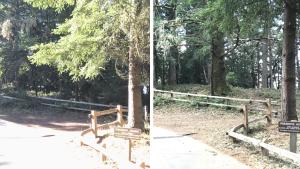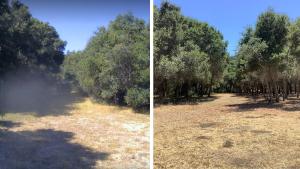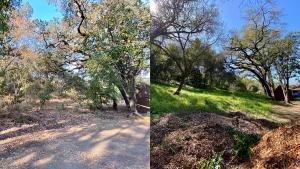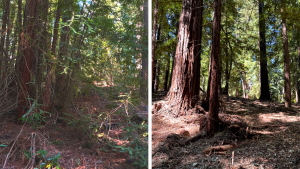Wildland fire prevention, preparation and response are part of Midpen's ongoing land stewardship. We reduce wildland fire severity and risk in our region by managing vegetation in the preserves with a focus on ecological health and wildland fire resilience, in alignment with our mission and policies.
In 2021, our new Wildland Fire Resiliency Program was approved, allowing us to proactively increase our ecologically sensitive vegetation management approximately six-fold over ten years.
Before new projects begin, biologists and archeologists conduct surveys to identify and protect sensitive plants, animals and cultural sites. Non-native and invasive plants are prioritized for removal over more fire-adapted native plant species.


Goals and Objectives
Beginning in 2021, we're proactively expanding our environmentally sensitive vegetation management six-fold over the next decade with our Wildland Fire Resiliency Program in order to:
- Promote healthy, resilient, fire-adapted ecosystems
- Reduce wildland fire risk
- Facilitate the response of fire agencies
The Wildland Fire Resiliency Program has four main elements:
- Vegetation Management Plan
Expanding environmentally sensitive vegetation management into new areas of our preserves for ecological health and public safety. - Preserve Maps to Assist Fire Agencies (Pre-plan and Resource Advisor maps)
Updated and expanded preserve maps provide critical information to fire agencies responding to wildland fire events, including water sources, roads and gates and sensitive natural and cultural resources. - Monitoring Plan
Collecting scientific data and monitoring to ensure the program is adaptable and meeting our goals. - Prescribed Fire Plan
Reintroducing prescribed fire to Midpen’s land management toolbox in 2024, in partnership with Cal Fire. Watch a presentation on the prescribed fire aspect of the program from a July 2022 virtual community open house event:

Stay informed!
Current Projects
As part of Midpen’s ecological approach to vegetation management, we are careful not to impact sensitive plants and wildlife. One way we do this is to avoid work during nesting bird season, which ends September 1.
In 2020, Midpen joined together with the San Jose Water Company, Santa Clara County FireSafe Council and Santa Clara County Parks to form the Los Gatos Creek Watershed Collaborative. This group was brought together to take a holistic look at forest health over nearly 1,000 acres in the Los Gatos Creek Watershed, which includes portions of Bear Creek Redwoods and Sierra Azul Open Space Preserves.
Funded in part through CAL FIRE’s Forest Health Program, the collaborative is working together to meet forest health and wildfire fuel management goals through understory thinning, removal of dead and dying trees and control of invasive species.
Crews will move between sites and across agency borders to proactively manage environmentally sensitive vegetation, reduce wildland fire risk and facilitate fire suppression.

This strategic fire management work at Rancho San Antonio Open Space Preserve was planned in partnership with the Los Altos Hills Fire Department. The project is expected to run through 2025 along the Chamise Trail from the Rhus Ridge Trail junction to the Ravensberry Trail junction. The work area will generally follow close to the ridgeline, where fuel breaks are most effective, and will include reducing brush, small trees and any dead vegetation in an ecologically sensitive manner to protect native plants and wildlife in the area.

As part of the Santa Cruz kangaroo rat Research and Adaptive Management project and the Los Gatos Creek Watershed Forest Health Project, crews are conducting road side vegetation removal within prime kangaroo rat habitat in Sierra Azul Open Space Preserve. Work is in a closed area of the preserve, and began in the summer of 2024. The work is expected to continue through spring 2025.
This work provides multiple benefits:
- By removing the root structures, the soil is being aerated.
- This creates a looser soil surface, critical for kangaroo rats to cache seeds and create burrows.
- The decrease in roadside vegetation also removes potential wildfire fuels.
- Removal or knobcone pines will allow for manzanita species to flourish.
Ongoing Work
Though wildland fires seldom start in Midpen preserves, our staff work year-round to prevent, prepare for and respond to fire by:
- Maintaining hundreds of miles of fuel breaks and fire roads throughout our preserves, some of which are used as emergency ingress and egress routes for neighbors.
- Annually training Midpen field staff as fire first responders
- Outfitting ranger trucks with water pumpers during fire season
- Reducing vegetation using conservation grazing on more than 6,500 acres on the San Mateo County Coast
- Enforcing regulations against smoking, fires and guns in the preserves

CZU Lightning Complex Fire
In August, 2020, fire-trained Midpen ranger and maintenance staff assisted Cal Fire in holding the north fire line at Old Haul Road, preventing the fire from reaching Midpen preserves and Skyline-area communities and beyond.
The lightning storm that sparked the CZU fire, also ignited four small fires on Midpen land that fire-trained ranger and maintenance staff quickly located and extinguished.
Hear directly from staff about their experience on the CZU fire line in this presentation given at a special public meeting of the Midpen board of directors on October 28, 2020.
Fire is a fact of life in California and everyone plays a role in living safely with it. More than 95% of wildland fires in California are caused by human activities, according to Cal Fire.
Do your part to prevent and prepare for fire by:
- Hardening your home against fire, create defensible space around it and have an evacuation plan
- Signing up for county emergency alerts.
- Recreating safely to prevent fires and so emergency resources are available to respond to fires: stay cool and bring plenty of water, or consider other plans.
- Stay aware of red flag warning weather when fire danger is highest and refraining from activities that could spark fires.
Helpful Resources
CAL FIRE’s Ready for Wildfire website
San Mateo County Fire Safe Council
San Mateo County emergency alerts
For those who choose to live in the wildland-urban interface, creating defensible space and hardening your home are some of the most important things you can do to protect your property.
Neighbors can apply here for a free permit allowing you to reduce vegetation on Midpen land, within 100 feet of occupied structures, to create defensible space around your home.
Application Process
- Obtain a free fire hazard inspection from your local fire agency.
- Fill out this online form.
- Midpen staff will schedule a site visit with you to discuss your project and program details.
Program Details
- The occupied structure should be in compliance with applicable planning, building, and zoning laws.
- Applicants and contractors must have general liability insurance and any required licenses.
- Cost of vegetation removal and any required environmental review are the applicant's responsibility.
Other requirements may be identified in the permit for consistency with Midpen’s resource management policies and practices.
Defensible Space Resources
Check with your local fire department for additional information about defensible space.
Questions? Contact Midpen at 650-691-1200 or info@openspace.org.
Recently Completed Project Highlights
















Project Updates and Related Stories





Partners
Midpen staff work cooperatively with neighbors, fire agencies and regional fire safe councils on fire prevention and preparedness efforts. The Midpen board of directors has this identified this work as an objective within strategic goal of protecting the positive environmental values of open space land.
Local fire departments (such as Palo Alto, Woodside Fire Protection District, and Santa Clara County), and the California Department of Forestry and Fire Protection (Cal Fire) are the agencies in our region that are responsible for fire suppression. Cal Fire’s role is supplemented by statewide mutual aid agreements for large wildland fire events.


